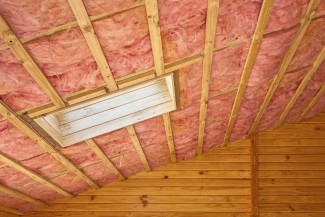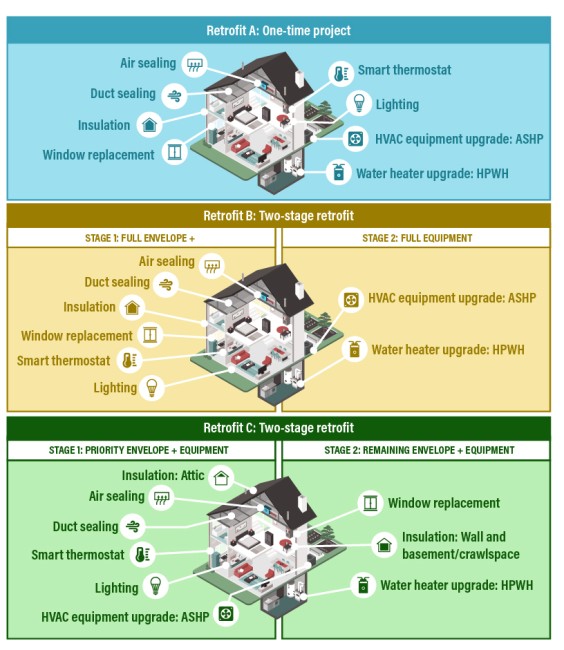Scaling Them to Address Climate Crisis Requires Federal Support
Upgrading homes with thick insulation, thorough air sealing, efficient heat pumps, and other measures can more than halve their energy use and planet-warming emissions, offering a win-win opportunity to improve residents’ comfort, lower their utility bills, and address the climate crisis, according to a report released today by the American Council for an Energy-Efficient Economy (ACEEE). The report shows that, to rapidly scale these retrofits, federal support is needed to offset upfront costs.
Deep retrofits that include a robust package of such upgrades can cut a home’s energy use by 58% to 79% and its emissions by 32% to 56%, depending on the home’s age and regional climate. They include simple measures, such as switching to LED light bulbs or buying insulated shades, and costlier ones, such as replacing the furnace, the windows, and the roof. For longer-term carbon reductions, they also include a shift to electric heating and cooling, notably via heat pumps. Such retrofits improve indoor air quality, even out temperatures, and reduce noise, but at $42,600 to $56,750, they cost more than most homeowners can afford.
“Simple steps deliver great bang for the buck, but if we’re serious about climate action, we need to do a lot more and make deep retrofits affordable and accessible to millions of homes,” says Jennifer Amann, the report’s lead author and a senior fellow in ACEEE’s buildings program. “The government needs to help scale these retrofits by subsidizing them, training contractors, and encouraging electrification.”
To guide potential government investments and boost customer interest, the report analyzed retrofit packages based on the most common pre-2000 home type in each major U.S. climate zone. It looked at breaking these packages into two stages to better manage their costs and meet customer needs. The analysis shows that completing retrofits in stages can be an effective strategy for scaling deep retrofits and achieving energy and carbon savings.
“One solution does not fit all,” says Dr. Rohini Srivastava, report co-author and an ACEEE senior researcher. She adds, “A home’s age and region matter. An old home in cold Chicago may need a different and more extensive mix of upgrades than a newer home in temperate Seattle.”
The report finds:
· Older homes in cold, mixed-humid, and marine climates benefit most from envelope upgrades (e.g., new windows; attic, wall, floor insulation) that can significantly cut energy use and emissions. A staged approach that prioritizes such upgrades delivers near-term gas savings, with more savings in later phases when HVAC and water heating are electrified.
· For newer homes in hot-humid and hot-dry climates, new HVAC equipment and select envelope measures (e.g., attic insulation) can reduce heating and cooling loads and contribute to energy and carbon savings.
· High-efficiency heat pumps and heat pump water heaters present the best opportunity for electrification when heating loads are smaller.
“Consumers can benefit by taking any of these approaches,” Amann says. “If they have an old and dying HVAC system, switching to an efficient electric heat pump along with air sealing and attic insulation may be good first steps. Rather than doing everything in the perfect order, it’s more important that they get started and do something.” She notes that less expensive measures, such as storm windows or insulated shades, ceiling fans, and high efficiency dehumidifiers, can quickly reduce energy use and emissions while improving residents’ comfort.
Rapid scaling of deep retrofits is needed to meet U.S. and global climate goals. A 2021 International Energy Agency report projects that existing residential buildings need to be retrofitted at the rate of 2.5% each year to reach the goal of net-zero emissions by 2050.
While the technology for deep retrofits exists, the report notes several barriers that limit its adoption: a lack of standardized insulation packages that reduce time and error; a limited range of heat pump products that deliver high-efficiency at lower cost; and the limited use of passive technologies that decrease building loads. In addition, most contractors are not yet ready to undertake a deep retrofit’s complexity, nor are homeowners ready for its costs.
To address these challenges, the report recommends that energy efficiency programs standardize retrofit packages, split upgrades into two or more phases, include electrification, and offer both financing and incentives.




